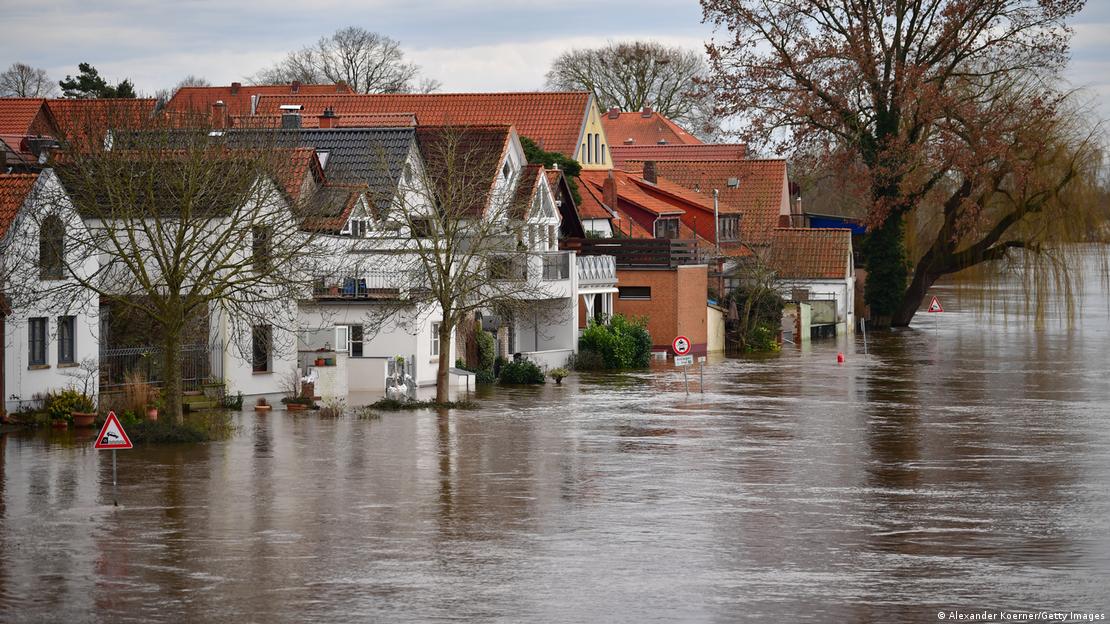Northwest Europe Floods
Status: Closed
| Type of posting | Posting date(EST): | Summary | Downloads |
|---|---|---|---|
| Post-Event Summary | 1/17/2024 5:00:00 AM |
|
|
| Copernicus EMS Shapefile | 1/12/2024 12:00:00 AM |
|
|
| Monitoring | 1/5/2024 6:00:00 AM |
|
Post-Event Summary | Summary
Posting Date: January 17, 2024, 5:00:00 AM
A series of rainfall events caused widespread flooding in Germany around the new year, bursting rivers, damaging crops, and destroying homes and businesses.
Through December 2023 and into January, a series of low-pressure systems moved across Germany, causing heavy rain and saturating soils. The Deutscher Wetterdienst (DWD), Germany’s meteorological service, reported that December 2023 was one of the ten wettest months in the country’s history. The regions of Lower Saxony, North Rhine-Westphalia, and Saxony-Anhalt, three of the most impacted areas by flooding, saw twice their average rainfall in December. Many of the flooded areas saw freezing temperatures follow the excessive precipitation earlier this month, which could potentially exacerbate damage and losses in these locales, given the expansion of the water in this case potentially leading to greater strain on building materials. That said, not all of the impacts of the colder weather may be bad for the flooding; in some cases, dikes may be strengthened, making them less likely to be breached by flood waters.

Map of flooded areas in Germany based on Copernicus Emergency Management Service data (Copernicus/Verisk)
Beyond the excessive rainfall, there are additional factors that have led to flooding in many areas, among them the disappearance or draining of wetlands around many of these rivers. According to Christian Wolter from the Leibniz Institute for Freshwater Ecology and Inland Fisheries in Berlin, "More than 70% of the wetlands along the rivers practically don't exist anymore. That of course also means that more than 70% of the historical retention areas, which the water had been able to flow into, are no longer there." Wolter also pointed to the straightening of waterways, especially the upper reaches of rivers that were straightened to carry rainfall away from the mountains as quickly as possible, as another driver of the significant impact of these floods.
The setup for this flooding is different from that of the July 2021 floods in Germany or some of the more typical summer events we have seen in recent years, for example the 2013 Germany event. Summer events tend to be driven more by more intense rainfall with higher totals for a single event, but shorter duration events in terms of precipitation. The recent flooding, however, was characterized by multiple rain events over an extended period, none of them especially significant on their own, but with a broadly similar accumulated impact. Another key difference from the 2021 event is the amount of heavy commercial and industrial exposure affected; this appears to be far less for this event, with the impacted areas containing primarily agricultural and residential exposure.

Sandbags and other equipment were used to protect houses and strengthen flood defenses. News sources showed different types of mobile dikes being deployed in the affected areas. In some areas, flooding was due to rising water levels from saturated ground even when defenses are not breached. Pumping stations were also deployed to alleviate flooding.
The agricultural industry in Germany has been particularly hard hit by this flooding. Farmers in Lower Saxony reported it to be the worst flooding in memory, with the regional farmer’s association estimating that virtually all of the region’s 35,000 farms had seen at least some damage from the event, in addition to hundreds of farm buildings. He noted, however, that they were fortunate relatively little livestock had been impacted or needed to be evacuated. The river Aller across Lower Saxony and Saxony-Anhalt was among those which had an outsized impact on farmers. Crops noted to be particularly impacted included potatoes and sugar beets. The frost could also have an impact on crops; whereas frost early in the season in a typical non-flood setting can actually help open up the ground for water to permeate, when the frost doesn’t reach the ground, it can leave said ground “tighter” later on and therefore less absorptive of water, negatively impacting crops.
Though the insurance take-up rate for the flood peril is higher in Germany than in many countries, only roughly half of German homeowners have flood insurance, according to the German Insurance Association (GDV), and in the heavily impacted area of Lower Saxony, this proportion is closer to 30% on residential risks. According to a Verisk study in 2021, approximately 14% of the global insurable losses on an average annual basis are due to the Flood peril; however, only 7% of the insured loss is, indicating a significant protection gap around this peril relative to others. Given this gap, and the potential for increases in flood event frequency and severity due to climate change, Flood is likely to continue to stay in the spotlight as a significant peril for the insurance industry to better understand and manage.
No additional ALERT activity is currently planned for this event. Please contact your Verisk representative with any additional questions.